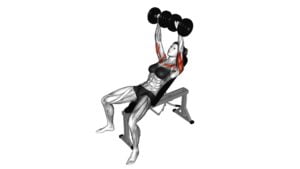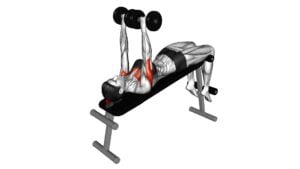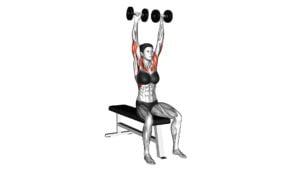Dumbbell Bench Press (female) – Video Exercise Guide & Tips

Are you a woman looking to strengthen your upper body?
Watch This Exercise Video
The dumbbell bench press is a fantastic exercise that targets your chest, shoulders, and triceps.
In this informative guide, we will show you the proper form and technique for performing the dumbbell bench press.
You'll also discover the recommended weight and repetitions, as well as modifications and variations to suit your fitness level.
Get ready to maximize your results and prevent injury with these valuable tips.
Let's get started!
Key Takeaways
- Dumbbell Bench Press targets multiple muscle groups in the upper body.
- It improves overall upper body strength.
- It activates pectoral muscles for stronger and more defined chest muscles.
- It engages deltoids for stabilization and control.
Benefits of Dumbbell Bench Press for Women
If you're a woman looking to strengthen your upper body, the dumbbell bench press can be a highly effective exercise for you. Not only does it target multiple muscle groups in your upper body, but it also helps improve your overall upper body strength.
During the dumbbell bench press, your pectoral muscles, deltoids, and triceps are activated, leading to increased muscle strength and tone.
The dumbbell bench press specifically targets your pectoral muscles, which are responsible for the movement of your arms across your chest. By regularly performing this exercise, you can develop stronger and more defined chest muscles.
Additionally, the dumbbell bench press also engages your deltoids, or shoulder muscles, which play a crucial role in stabilizing and controlling the movement of your arms during the exercise.
Furthermore, the triceps, located at the back of your upper arms, are also activated during the dumbbell bench press. As you lower and push the dumbbells, your triceps contract, helping you extend your arms and complete the exercise.
Proper Form and Technique for Dumbbell Bench Press
To perform the dumbbell bench press with proper form and technique, start by lying on a flat bench with a dumbbell in each hand. Here's how to do it correctly:
- Position yourself on the bench with your feet flat on the floor and your back pressed firmly against the bench.
- Hold the dumbbells with an overhand grip and extend your arms straight up, directly above your chest.
- Lower the dumbbells slowly and under control, bending your elbows until they reach a 90-degree angle.
- Push the dumbbells back up to the starting position, fully extending your arms.
It's important to avoid these common mistakes when performing the dumbbell bench press:
- Arching your back or lifting your hips off the bench.
- Flaring your elbows out to the sides instead of keeping them close to your body.
- Using too much weight and sacrificing proper form.
- Rushing through the exercise instead of maintaining control throughout the movement.
For this exercise, you'll need a flat bench and a pair of dumbbells. Make sure to choose a weight that challenges you but still allows you to maintain proper form.
Now that you know the proper form and technique for the dumbbell bench press, let's move on to the next section about the recommended weight and repetitions for this exercise.
Recommended Weight and Repetitions for Dumbbell Bench Press
Now that you know the proper form and technique for the dumbbell bench press, it's time to determine the recommended weight and repetitions for this exercise. The recommended weight for the dumbbell bench press will vary depending on your fitness level and strength. It's important to choose a weight that challenges you but still allows you to maintain proper form throughout the exercise.
If you're a beginner, start with lighter weights to focus on mastering your form and technique. Aim for 8-12 repetitions per set, with 2-3 sets in total. As you become more experienced and stronger, you can gradually increase the weight and decrease the number of repetitions. For intermediate to advanced lifters, using heavier weights and doing 6-8 repetitions per set, with 3-4 sets, can help build strength and muscle.
Remember to always listen to your body and adjust the weight accordingly. If you're unable to complete the desired number of repetitions with proper form, it may be a sign that the weight is too heavy for you. On the other hand, if you're able to do more repetitions with ease, it may be time to increase the weight for a more challenging workout.
Now that you're familiar with the recommended weight and repetitions for the dumbbell bench press, let's move on to exploring modifications and variations of this exercise for women.
Modifications and Variations of Dumbbell Bench Press for Women
For women looking to add variety to their dumbbell bench press routine, there are several modifications and variations available. These dumbbell bench press modifications can help target different muscle groups, prevent plateau, and keep your workouts challenging and engaging.
Here are some alternative variations you can try:
- Incline Dumbbell Bench Press: This variation focuses on the upper chest and shoulders. Adjust the bench to a 45-degree angle and perform the bench press as usual.
- Single-Arm Dumbbell Bench Press: By using only one arm at a time, you engage your core and stabilizing muscles more. This variation also helps to correct any muscle imbalances.
- Close-Grip Dumbbell Bench Press: Placing your hands closer together targets the triceps more. Keep your elbows tucked in as you press the dumbbells up.
- Neutral-Grip Dumbbell Bench Press: Using dumbbells with a neutral grip (palms facing each other) reduces strain on the wrists and targets the chest and triceps effectively.
By incorporating these dumbbell bench press modifications and alternative variations into your routine, you can challenge your muscles in new ways and avoid boredom.
Now, let's move on to the next section, where we'll discuss tips for maximizing results and preventing injury in dumbbell bench press.
Tips for Maximizing Results and Preventing Injury in Dumbbell Bench Press
To maximize your results and prevent injury in the dumbbell bench press, it's important to follow proper form and technique.
First and foremost, start with a weight that challenges you but allows you to maintain proper form throughout the exercise. This will help you avoid straining your muscles or joints.
Secondly, make sure to engage your core and keep your back flat against the bench to provide stability and protect your spine.
When performing the exercise, focus on maintaining a controlled and steady movement, avoiding any jerking or swinging motions. This will ensure that you're targeting the intended muscles and reducing the risk of injury.
Additionally, always warm up before starting your workout to increase blood flow and prepare your muscles for the exercise.
Lastly, listen to your body and know your limits. It's better to start with lighter weights and gradually increase as you build strength, rather than pushing yourself too hard and risking injury.
Frequently Asked Questions
Can Dumbbell Bench Press Help in Reducing Breast Size for Women?
Yes, dumbbell bench press can help in reducing breast size for women. When you perform dumbbell bench press exercises, you engage your chest muscles, which can lead to overall weight loss and muscle toning.
How Long Does It Take to See Results From Dumbbell Bench Press?
When it comes to seeing results from dumbbell bench press, it depends on various factors such as your current fitness level, diet, and consistency.
Generally, you can start noticing improvements in strength and muscle tone within a few weeks of regular training.
However, significant changes in body composition, like reducing breast size, may take longer and require a combination of exercises, proper nutrition, and overall weight loss.
Remember to start with beginner variations and avoid common mistakes for effective and safe progress.
Can Dumbbell Bench Press Help in Correcting Posture?
Yes, dumbbell bench press can help in correcting your posture by strengthening your back muscles. When you perform this exercise properly, it targets your chest, shoulders, and triceps, but it also engages your back muscles as stabilizers.
Is It Safe for Pregnant Women to Perform Dumbbell Bench Press?
During pregnancy, it's important to be cautious with exercise. Pregnancy exercise recommendations generally advise avoiding activities that put excessive strain on the abdomen or involve lying flat on your back. Weightlifting can be done with caution, but certain precautions need to be taken.
It's always best to consult with your healthcare provider before starting any new exercise routine, especially during pregnancy. They'll be able to provide personalized recommendations based on your individual circumstances.
Can Dumbbell Bench Press Help in Improving Upper Body Strength for Women?
Dumbbell bench press is a great exercise to improve upper body strength for women. It targets the chest, shoulders, and triceps.
By incorporating variations of the dumbbell bench press, you can also work on improving shoulder stability. This exercise helps in building muscle and increasing overall strength.
Remember to start with lighter weights and gradually increase as you get stronger. Consult with a fitness professional to ensure proper form and technique.
Conclusion
In conclusion, the dumbbell bench press is a highly effective exercise for women that offers numerous benefits. By using proper form and technique, women can strengthen their chest, shoulders, and triceps while also improving overall upper body strength.
It's important to choose the appropriate weight and repetitions, and modifications can be made to suit individual needs and goals. By following these tips and guidelines, women can maximize their results and prevent injury during the dumbbell bench press.

Author
Years ago, the spark of my life’s passion ignited in my mind the moment I stepped into the local gym for the first time. The inaugural bead of perspiration, the initial endeavor, the very first surge of endorphins, and a sense of pride that washed over me post-workout marked the beginning of my deep-seated interest in strength sports, fitness, and sports nutrition. This very curiosity blossomed rapidly into a profound fascination, propelling me to earn a Master’s degree in Physical Education from the Academy of Physical Education in Krakow, followed by a Sports Manager diploma from the Jagiellonian University. My journey of growth led me to gain more specialized qualifications, such as being a certified personal trainer with a focus on sports dietetics, a lifeguard, and an instructor for wellness and corrective gymnastics. Theoretical knowledge paired seamlessly with practical experience, reinforcing my belief that the transformation of individuals under my guidance was also a reflection of my personal growth. This belief holds true even today. Each day, I strive to push the boundaries and explore new realms. These realms gently elevate me to greater heights. The unique combination of passion for my field and the continuous quest for growth fuels my drive to break new ground.







